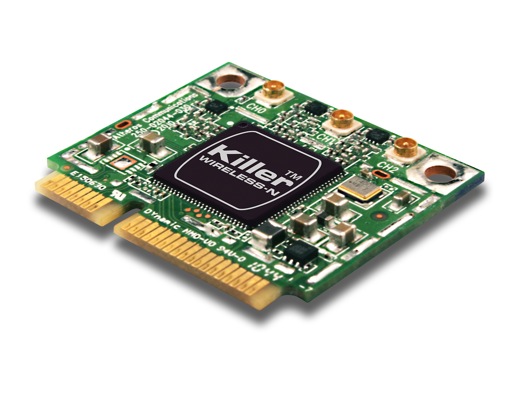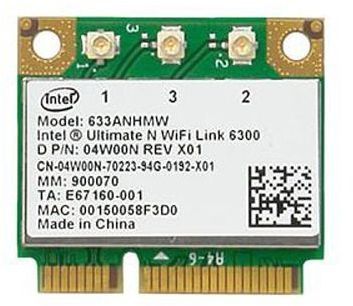Killer Wireless-N 1103 Review: Can Qualcomm Take On Centrino?
Killer Wireless: Is It Able To Usurp Intel's Centrino?
Some people swear by the performance benefits promised by Killer network adapters. Others question its value in the real world. Back in 2009, we took a look at the company's Xeno Pro Gaming Network Card and concluded:
"...impressive specifications and a laundry list of features don't necessarily translate into real-world performance boosts. Without the core ability to wow us with ultra-low network latencies compared to less expensive solutions (like a freeware Firefox plugin), configuring your torrent client, or simply turning off your downloads during your gaming session, the Killer Xeno Pro is a tough sell as a must-have gaming NIC."
You may recall that the Killer NIC derived its strength from a few key enhancements over regular integrated network controllers. First and foremost, the adapter used an on-board 400 MHz processor to handle all network packet processing. This offloaded traffic from the host CPU and sidestepped the Windows networking stack. Killer actually had a Linux distribution on the card, turning it into a sort of PCI Express-based co-computer.
Unfortunately, a $130 price tag on the card was a deal-breaker, especially since we were able to reproduce many of its functions using common sense and freely available software. Really, we thought, there was just no reason to spend that much on questionable benefits.
Almost three years later, we have Qualcomm Atheros, having purchased Bigfoot Networks and its Killer portfolio in August of last year 2011, making its first push into the world of Killer Wi-Fi. Qualcomm wants to make Killer Wireless-N the de facto mini-PCIe value-add choice for notebooks aimed at gamers and enthusiasts. However, the PowerPC-based NPU that formed the heart of Killer’s old sales pitch is nowhere to be seen on the wireless front. Instead, we’re given tweaked firmware and software layered on top of Qualcomm's AR9380 single-chip, dual-band radio. Is that enough to make any sort of difference?
Qualcomm is going up against Intel in this segment. Specifically, we’re looking at the Killer Wireless-N 1103, which features 3x3:3 MIMO. This means three transmit and three receive antenna chains, respectively, along with three spatial streams. The raw spec on this is 450 Mb/s—a far more impressive number than the 300 Mb/s found on more common 3x3:2 (two spatial streams) configurations. Intel was one of the first to release a decent 3x3:3 notebook adapter in its Ultimate-N WiFi Link 5300, and now there’s the Centrino Ultimate-N 6300.
As a point of contrast, Newegg lists the 6300 for $40. The cheapest mini-PCIe Wi-Fi card on the site is Intel’s WiFi Link 1000, a 2.4 GHz-only, 1x2 802.11n adapter for only $14. Would you pay $26 to go from 1x2 to 3x3:3? In a heartbeat, right? This is why we’re not concerned with ordinary, low-end performance in this article. We’re here to determine if the Killer Wireless-N 1103 really has what it takes to go up against Intel and command top dollar in the premium wireless world.
Get Tom's Hardware's best news and in-depth reviews, straight to your inbox.
Current page: Killer Wireless: Is It Able To Usurp Intel's Centrino?
Next Page Killer Wireless-N 1103: Nebulous Claims To Superiority-
phamhlam I wish they would build better PCI-Express WiFi Adapter. Some of us can't have a cable going through our house or have our computer sit next to the router.Reply -
KelvinTy I think if you have the lowest latency at your end and leave everything on the server and internet end. Then it would be a lot better, especially there is input lag from everything, monitor, mouse, keyboard, wireless card, router and internet...Reply -
reghir There are 2 versions of the E4200 did you use version 1 or 2 as version 2 increases to 450Mbps on both bands and full spatial on its 3X3 streams?Reply -
MKBL I hope TH will review on powerline Ethernet adapter against typical RJ45 and wifi. For the same reason as phalmhlam, my desktop is connected to router by a long cable running across floor, which bothers me and my family sometimes. I've been considering powerline ethernet, but I can't make decision between that and wireless-N, because I have no idea which one has better performance/price.Reply -
CaedenV Great article! I learned quite a few things from it.Reply
I still think I will be waiting for 802.11ac before upgrading from G though. -
jaylimo84 M. Van Winkle,Reply
Thanks for this nice article.
I own an Alienware M17xR3, with the Killer 1103.
Upon installation, the driver was causing me issues (nothing big tho), and I decided to follow a forum recommendation and install the Atheros Osprey driver instead of Killer's.
It seems the two card are identical apart from the name on it. (Maybe I am misleaded)
It could be interesting to see if the Killer 1103 gets any improvement using the Killer driver vs. the vanilla Atheros drivers, and see if "years of working with the windows tcp stack" pays off. Or if your performance improvement is due to a good, but still normal card. -
CaedenV MKBLI hope TH will review on powerline Ethernet adapter against typical RJ45 and wifi. For the same reason as phalmhlam, my desktop is connected to router by a long cable running across floor, which bothers me and my family sometimes. I've been considering powerline ethernet, but I can't make decision between that and wireless-N, because I have no idea which one has better performance/price.Indeed, it is an issue. I ended up wiring the house through the HVAC ducts, which is a terrible idea (breaks all sorts of building codes), but better than drilling holes all throughout the house only to move to wireless within the next 5-10 years.Reply -
XmortisX I would like to try this out. If they can make a good pci-e/pci version of this card then definitely would try to push it with my clients. Even though we may get more labor hours for running wires the convenience and idea of avoiding HVAC ducts building codes makes this appealing.Reply

